Ovary (botany)
In the flowering plants, an ovary is a part of the female reproductive organ of the flower or gynoecium. Specifically, it is the part of the pistil which holds the ovule(s) and is located above or below or at the point of connection with the base of the petals and sepals. The pistil may be made up of one carpel or of several fused carpels (e.g. dicarpel or tricarpel), and therefore the ovary can contain part of one carpel or parts of several fused carpels. Above the ovary is the style and the stigma, which is where the pollen lands and germinates to grow down through the style to the ovary, and, for each individual pollen grain, to fertilize one individual ovule. Some wind pollinated flowers have much reduced and modified ovaries.
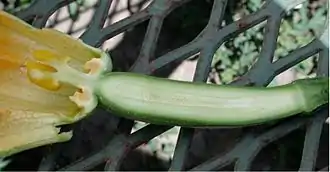
_(255_30)_Tulip%253B_cross-section.jpg.webp)
Fruits
A fruit is the mature, ripened ovary of a flower following double fertilization in an angiosperm. Because gymnosperms do not have an ovary but reproduce through double fertilization of unprotected ovules, they produce naked seeds that do not have a surrounding fruit. Fruits are responsible for the dispersal and protection of seeds in angiosperms and cannot be easily characterized due to the differences in defining culinary and botanical fruits.
Development
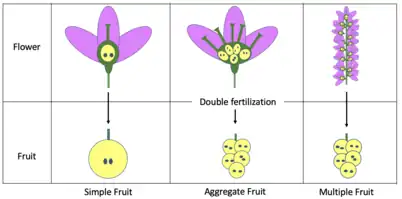
After double fertilization and ripening, the ovary becomes the fruit, the ovules inside the ovary become the seeds of that fruit, and the egg within the ovule becomes the zygote.[1][2] Double fertilization of the central cell in the ovule produces the nutritious endosperm tissue that surrounds the developing zygote within the seed.[2] Angiosperm ovaries do not always produce a fruit after the ovary has been fertilized. Problems that can arise during the developmental process of the fruit include genetic issues, harsh environmental conditions, and insufficient energy which may be caused by competition for resources between ovaries; any of these situations may prevent maturation of the ovary.[3][4][5][6]
Dispersal and evolutionary significance
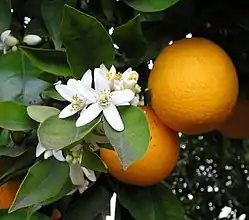
Fruits are important in the dispersal and protection of seeds, and variation in fruit shape or size results from an evolutionary response that aids in the dispersal of seeds in different environments.[8][9] For example, the seeds of large fleshy fruits are often dispersed through endozoochory; this means that animals consume the fleshy fruit and as a result disperse its seeds with their movement.[10] The seeds of fruits can be dispersed by endozoochory, gravity, wind, or other means.
.jpg.webp)
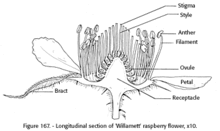
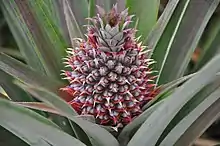
Complications and types of fruits
There are some complications to the definition of a fruit, as not all botanical fruits can be identified as culinary fruits. A ripened ovary may be a fleshy fruit such as a grapefruit or a dry fruit such as a nut. Further complicating this, culinary nuts are not always botanical nuts; some culinary nuts such as the coconut and almond are another type of fruit called a drupe.[11][12]
In this same way, not all "fruits" are true fruits. A true fruit only consists of the ripened ovary and its contents. Fruits can be separated into three major categories: simple fruits, aggregate fruits, and multiple fruits. Simple fruits like oranges are formed from a single ovary which may or may not consist of multiple parts, while aggregate and multiple fruits are formed from several ovaries together.[13] Aggregate fruits like raspberries are the ripened ovaries of one flower that form a single fruit, and multiple fruits like pineapples are formed from the ovaries of separate flowers that are close together.[13][14][15]
Because aggregate and multiple fruits are formed from many ripened ovaries together, they are actually infructescences or groups of fruits that are arranged together in a structure.[13] Some fruits, like the apple, are accessory fruits which can include other parts of the flower such as the receptacle, hypanthium, perianth, or calyx in addition to the mature and ripened ovary.[16]
Parts of the ovary
Locules are chambers within the ovary of the flower and fruits. The locules contain the ovules (seeds), and may or may not be filled with fruit flesh. Depending on the number of locules in the ovary, fruits can be classified as uni-locular (unilocular), bi-locular, tri-locular or multi-locular. Some plants have septa between the carpels; the number of locules present in a gynoecium may be equal to or less than the number of carpels, depending on whether septa are present.
The ovules are attached to parts of the interior ovary walls called the placentae. Placental areas occur in various positions, corresponding to various parts of the carpels that make up the ovary. See Ovule#Location within the plant. An obturator is present in the ovary of some plants, near the micropyle of each ovule. It is an outgrowth of the placenta, important in nourishing and guiding pollen tubes to the micropyle.[17]
The ovary of some types of fruit is dehiscent; the ovary wall splits into sections called valves. There is no standard correspondence between the valves and the position of the septa; the valves may separate by splitting the septa (septicidal dehiscence), or by spitting between them (loculicidal dehiscence), or the ovary may open in other ways, as through pores or because a cap falls off.
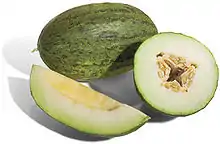
 In this Peganum harmala, the ovary of a fruit has split into valves.
In this Peganum harmala, the ovary of a fruit has split into valves.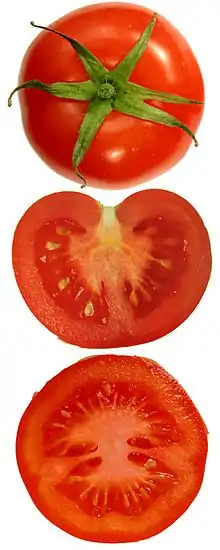 The seeds in a tomato fruit grow from placental areas at the interior of the ovary. (This is axile placentation in a bi-locular fruit.)
The seeds in a tomato fruit grow from placental areas at the interior of the ovary. (This is axile placentation in a bi-locular fruit.) The placentae in Lunaria are along the margins of the fruit, where two carpels fuse. (This is parietal placentation in a bi-locular fruit.)
The placentae in Lunaria are along the margins of the fruit, where two carpels fuse. (This is parietal placentation in a bi-locular fruit.).jpg.webp) The valves of Lunaria fruit fall to reveal a septum that was between the two carpels of the ovary.
The valves of Lunaria fruit fall to reveal a septum that was between the two carpels of the ovary.
Classification based on position

The terminology of the positions of ovaries is determined by the insertion point, where the other floral parts (perianth and androecium) come together and attach to the surface of the ovary.[18] If the ovary is situated above the insertion point, it is superior; if below, inferior.
Superior ovary
A superior ovary is an ovary attached to the receptacle above the attachment of other floral parts. A superior ovary is found in types of fleshy fruits such as true berries, drupes, etc. A flower with this arrangement is described as hypogynous. Examples of this ovary type include the legumes (beans and peas and their relatives).
Half-inferior ovary
A half-inferior ovary (also known as “half-superior”, “subinferior,” or “partially inferior,”) is embedded or surrounded by the receptacle.[19] This occurs in flowers of the family Lythraceae, which includes the crape myrtles. Such flowers are termed perigynous or half-epigynous. In some classifications, half-inferior ovaries are not recognized and are instead grouped with either the superior or inferior ovaries.
More specifically, a half-inferior ovary has nearly equal portions of ovary above and below the insertion point. Other varying degrees of inferiority can be described by other fractions. For instance, a "one-fifth inferior ovary" has approximately one fifth of its length under the insertion point. Likewise, only one quarter portion of a "three-quarters inferior ovary" is above the insertion.
Inferior ovary
An inferior ovary lies below the attachment of other floral parts. A pome is a type of fleshy fruit that is often cited as an example, but close inspection of some pomes (such as Pyracantha) will show that it is really a half-inferior ovary. Flowers with inferior ovaries are termed epigynous. Some examples of flowers with an inferior ovary are orchids (inferior capsule), Fuchsia (inferior berry), banana (inferior berry), Asteraceae (inferior achene-like fruit, called a cypsela) and the pepo of the squash, melon and gourd family, Cucurbitaceae.
See also
References
- Raghavan, V. (2003-07-25). "Some reflections on double fertilization, from its discovery to the present: Tansley review". New Phytologist. 159 (3): 565–583. doi:10.1046/j.1469-8137.2003.00846.x.
- Linkies, Ada; Graeber, Kai; Knight, Charles; Leubner-Metzger, Gerhard (2010). "The evolution of seeds". New Phytologist. 186 (4): 817–831. doi:10.1111/j.1469-8137.2010.03249.x. PMID 20406407.
- Stephenson, Andrew G. (1980). "Fruit Set, Herbivory, Fruit Reduction, and the Fruiting Strategy of Catalpa Speciosa (Bignoniaceae)". Ecology. 61 (1): 57–64. doi:10.2307/1937155. ISSN 0012-9658. JSTOR 1937155.
- Willson, Mary F.; Price, Peter W. (1977). "The Evolution of Inflorescence Size in Asclepias (Asclepiadaceae)". Evolution. 31 (3): 495–511. doi:10.2307/2407517. ISSN 0014-3820. JSTOR 2407517. PMID 28563471.
- Pawsey, C. K. (1960-01-01). "Cone Production Reduced, Apparently by Drought, in the South-East of South Australia". Australian Forestry. 24 (1): 74–75. doi:10.1080/00049158.1960.10675890. ISSN 0004-9158.
- Wyatt, Robert (1982). "Inflorescence Architecture: How Flower Number, Arrangement, and Phenology Affect Pollination and Fruit-Set". American Journal of Botany. 69 (4): 585–594. doi:10.2307/2443068. ISSN 0002-9122. JSTOR 2443068.
- Kim, In-Sun (2003). "Sequential Changes of Pericarp Ultrastructure in Citrus reticulata Hesperidium". Applied Microscopy. 33 (1): 79–92. ISSN 2287-5123.
- Gardocki, Mary; Zablocki, Heather; El-Keblawy, Ali; Freeman, D. (2000). "Heterocarpy in Calendula micrantha (Asteraceae): The effects of competition and availability of water on the performance of offspring from different fruit morphs". Evolutionary Ecology Research. 2: 701–718.
- Jordano, Pedro (1995). "Angiosperm Fleshy Fruits and Seed Dispersers: A Comparative Analysis of Adaptation and Constraints in Plant-Animal Interactions". The American Naturalist. 145 (2): 163–191. doi:10.1086/285735. hdl:10261/42645. ISSN 0003-0147. JSTOR 2463122. S2CID 86615972.
- Willson, Mary (2000). Fenner, M. (ed.). "The Ecology of Seed Dispersal". Seeds: The Ecology of Regeneration in Plant Communities (2nd ed.): 85–110. doi:10.1079/9780851994321.0085. ISBN 9780851994321.
- Geiselhart, Sabine; Hoffmann-Sommergruber, Karin; Bublin, Merima (2018-08-01). "Tree nut allergens". Molecular Immunology. 100: 71–81. doi:10.1016/j.molimm.2018.03.011. ISSN 0161-5890. PMID 29680588. S2CID 5069722.
- Kusari, Ayan; Han, Allison; Eichenfield, Lawrence (2018-10-30). "Recent advances in understanding and preventing peanut and tree nut hypersensitivity". F1000Research. 7: 1716. doi:10.12688/f1000research.14450.1. ISSN 2046-1402. PMC 6208566. PMID 30467518.
- Guertin, P.; Barnett, L.; Denny, E.G.; Schaffer, S.N. (2015). USA National Phenology Network Botany Primer. USA-NPN Education and Engagement Series 2015-001. pp. 51–53.
- Graham, Julie; Jennings, Nikki (2009). Jain, S. Mohan; Priyadarshan, P.M. (eds.). Breeding Plantation Tree Crops: Temperate Species. New York, NY: Springer Science & Business Media. pp. 233–248. ISBN 978-0-387-71203-1.
- Moyle, Richard; Fairbairn, David J.; Ripi, Jonni; Crowe, Mark; Botella, Jose R. (2005). "Developing pineapple fruit has a small transcriptome dominated by metallothionein". Journal of Experimental Botany. 56 (409): 101–112. doi:10.1093/jxb/eri015. PMID 15520025.
- Watkins, Chris B.; Liu, Rui Hai (2011). "Pome Fruit". In Terry, Leon (ed.). Health-promoting Properties of Fruits and Vegetables. Wallingford: CABI. pp. 196–217. ISBN 978-1-84593-529-0. OCLC 758335853.
- Hickey, M.; King, C. (2001), The Cambridge Illustrated Glossary of Botanical Terms, Cambridge University Press
- Soltis, Douglas E.; Fishbein, Mark; Kuzoff, Robert K. (2003). "Evolution of Epigyny". International Journal of Plant Sciences. 164 (S5): S251–S264. doi:10.1086/376876. S2CID 83871403.
- Soltis, Douglas E.; Hufford, Larry (2002). "Ovary Position Diversity in Saxifragaceae". International Journal of Plant Sciences. 163 (2): 277–293. doi:10.1086/324528. S2CID 85947971.